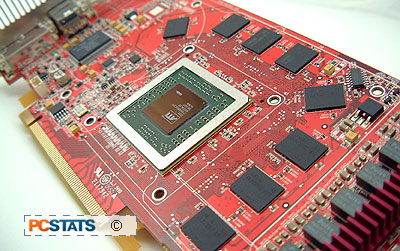
Like its predecessor the ATI 'R520,' the 'R580' VPU is built on
TSMC's 0.09 micron manufacturing process and contains a nice round 384 million
transistors. The architecture from core to core is pretty close. The extra 63
million transistors give the ATI 'R580' core the ability to process 48 pixel
shaders at any given time.
Aside from that major change, things are pretty much the same. For instance the 'R580' and 'R520' have the same number of vertex pipelines (there are 8), Z Compare units (16 of those) and have the same maximum threads (512 in there).
ATi also increased the clock speed of the 'R580' core slightly to 650 MHz for
its Radeon X1900 XTX, up 25MHz from 625 MHz for the Radeon X1800 XT.
ATI's Little (Big) Slip Up
 There is no support for HDCP (High bandwidth
Digital Content Protection) with the Radeon X1900XTX. With ATi incorporating
H.264 decoding and transcoding into the graphics core, without HDCP support it
is basically a wasted feature.
There is no support for HDCP (High bandwidth
Digital Content Protection) with the Radeon X1900XTX. With ATi incorporating
H.264 decoding and transcoding into the graphics core, without HDCP support it
is basically a wasted feature.
ATi does
state this on its website about HDCP "This feature is
supported by the ASIC and can be specified by PC manufacturers for its
add-in-boards. This feature is not typically enabled on stand alone cards."
While this might not be much of a concern right now, when
Windows Vista and high definition movies are released later in the year,
consumers who forked out a ton of money to buy a Radeon X1900 XTX videocard may be out of luck.
I guess the only saving grace is that users who are
contemplating such a videocard right now are often enthusiasts who have a short
upgrade cycle, but usually the group likes to upgrade on its own terms, not
someone else's. Daily Tech has a great news blurb on ATi's on again/off again HDCP support and
FiringSquad has a nice article on HDCP support and why it is important.
PCSTATS dug through the mirky world we're all going to be facing in this article - Windows Vista, HDCP and Digital Rights Management - it's a concise read if you like to get up to speed on these
impending changes.
|
experts tip: one dvi port or the other? |
|
ati and its supporting manufacturers do not label which dvi output is
the primary and which is the secondary because it doesn't matter. With
older videocards, if you plug the primary monitor into the wrong port
sometimes you'll be greeted by no display. With modern ATi videocards,
plug the monitor into whatever port you want and it will auto detect which
port the monitor is plugged into. If you're using dual monitors and want
the primary and secondary monitors to be reversed, swapping the outputs is
as easy as a few mouse clicks since it's integrated into the driver, those
dusty VGA cables can stay attached the whole time. ;-) |
| Comments and Feedback? Suggest a Tweak. |
High Definition Video
High Definition video content is right around the corner and
2006 is reminiscent of the time when DVD's were first released.
HD videos are promising to be very taxing on system recourses too. In order to
meet the High Definition processing task, ATi has built into
every X1xxx series core what it calls 'AVIVO technology.'
With the computer industry heavily pushing the digital home, it makes sense
for ATi and nVIDIA to integrate some form of High Definition accelerators into
each companies respective products. We just wish the silly names wouldn't always
have to follow suit.
Now, what do you know about Avivo?
